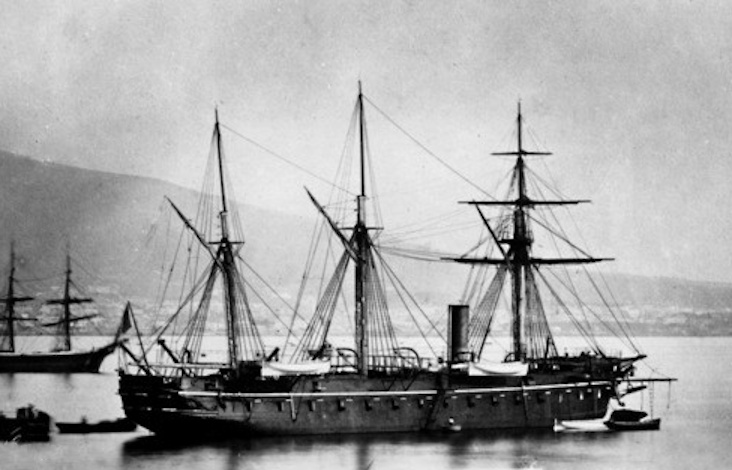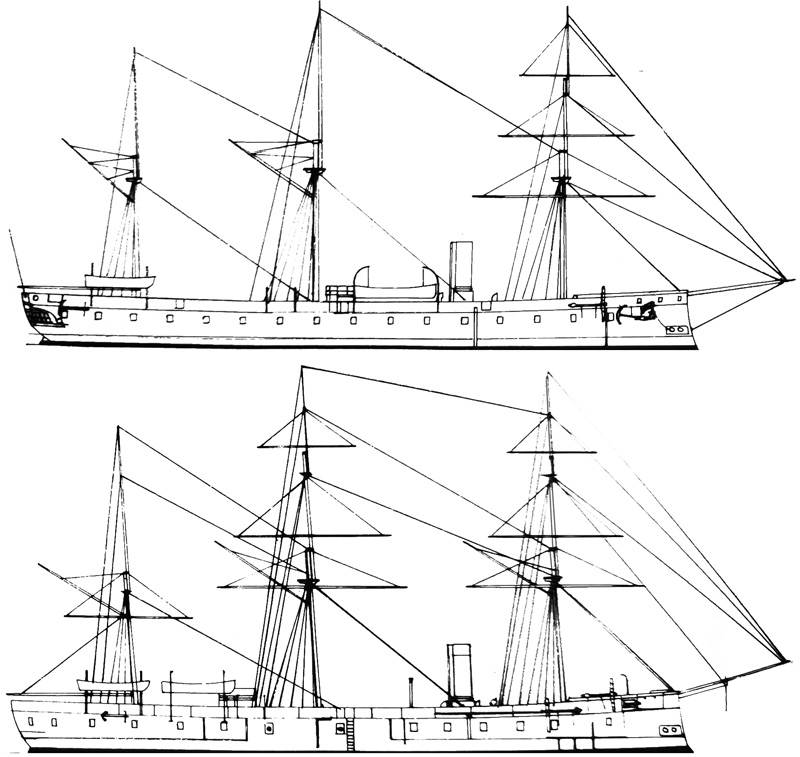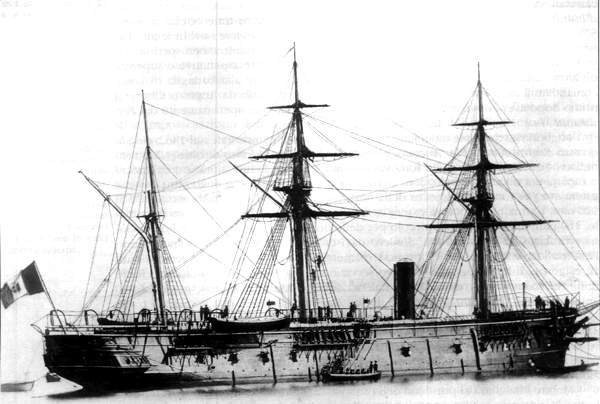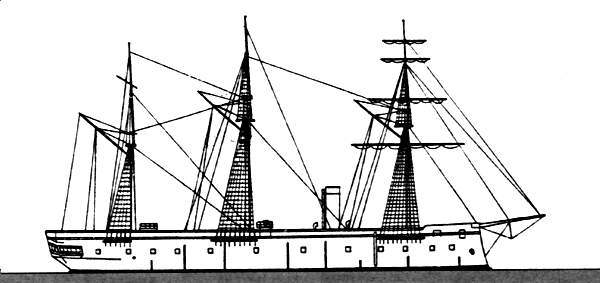 Italian Regia Marina, 1861-1879: Principe di Carignano, Messina, Conte Verde
Italian Regia Marina, 1861-1879: Principe di Carignano, Messina, Conte Verde
The Principe di Carignano class were three sister ironclad of the Italian Regia Marina (Royal Navy) in the 1860s: Principe di Carignano, Messina, and Conte Verde, originally ordered as wooden frigates in Italy but converted as ironclads, and the first to be built in Italy. Inexperience of Italian shipyards and redesign meant a long construction times and only Principe di Carignano was completed in time to be at the battle of Lissa, in the 3rd Italian War of Independence, she in fact led the Italian battleline, but was not engaged. By the 1870s, the three Principe di Carignano-class had little left for service life before scrapping or modernization and were stricken in 1875 and 1880, after barely nine years of service.
Development history
The first two vessels of that class came from a completely different program. They were large steam frigates ordered by the Regia Marina Sarda (Royal Sardinian Navy) before the unification, and purchased while on the stocks by the newly created Regia Marina, and soon it was decied to convert these as ironclads. The third of these frigates, Principe Umberto, was too advanced for conversion and completed in her original state. The conversion design was worked out by Inps. Eng. Felice Mattei. As the class design progressed, a fourth ship to be named Conte Verde was also built, but to a modified design, as an ironclad frigate, by Inps. Eng. Giuseppe De Luca.

If the first had a “classic” complete belt in wrought iron plates and 121 mm thick, Conte Verde had a partial one as it was obvious she would not be completed in time. These could have been the first Italian Ironclads, but the conversion time had them completed just as the third unification war started. They came as part of a major naval expansion program, or a scope never seen in this area. Italy wanted its fleet of ironclads to defeat the arch-enemy, the Austrian Navy, ruling the adriatic at the time and controlling Venetia. A war was inevitable and the Navy prepared for such confrontation by trying to acquire as many ironclads as possible, buy buying or purchasing them abroad, compensating its lack of experience by numbers.
The Austro-Italian ironclad arms race
⚙ The Austro-Italian naval Arms Race prior to Lissa (1864) | |
 Regia Marina Regia Marina |  KuK Kriegsmarine KuK Kriegsmarine |
|
Formidabile class 1860 Principe di Carignano class 1861 Re d'Italia class 1861 Regina Maria Pia class (1862) Roma class (1863) Affondatore (1863) Principe Amedeo class (ordered 1865) |
Drache class (1860) Kaiser Max class (1861) Erzherzog Ferdinand Max class (1863) |
Design of the class
Hull and general design
The Principe di Carignano class ships had about the same dimensions overall: Principe de Carignano measured 72.98 meters (239 ft 5 in) between perpendiculars for 15.1 m (49 ft 6 in) in beam, and a draft of 7.18 m (23 ft 7 in), for a displacement of 3,446 long tons (3,501 t) normal, and then 3,912 long tons (3,975 t) fully loaded. Messina was slightly shorter at 72.8 m (238 ft 10 in) between perpendiculars same beam and larger draft at 7.27 m (23 ft 10 in), 3,868 long tons (3,930 t) normal, but 4,245 long tons (4,313 t) fully loaded. Conte Verde, the last one and largest compared to her sisters, measured 73.7 m (241 ft 10 in) still between perpendiculars, was beamier at 15.3 m (50 ft 2 in) but with less draught at 6.5 m (21 ft 4 in), less displacement at 3,514 long tons (3,570 t) normal and 3,866 long tons (3,928 t) fully loaded. Given their equipment, they all had a crew of 572 officers and men, customary for the number of guns and need to manage the machinery and sails.
Powerplant
The Principe di Carignano had a single shaft with four bladed screw propeller, driven by a single-expansion marine steam engine. It was fed by steam produced in six coal-fired and cylindrical fire-tube boilers, all truncated into a single funnel. Total output reached 1,968 horsepower (1,468 kW) indicated (hpi). This enabled a top speed of 10.2 to 11.4 knots (18.9 to 21.1 km/h; 11.7 to 13.1 mph). Conte Verde was the fastest perhaps because she had a slightly better lenght ratio, less draft and displacement. In total they could cruise on 1,200 nautical miles (2,200 km; 1,400 mi) on their steam and coal reserve alone, at 10 knots (19 km/h; 12 mph), unilimited (with a speed probably close to 8-10 knots) with their three masts, but only Principe di Carignano was rigged as a barquentine. The two others were rigged as barques (Two square masts, one boom mast).
Armament
The Principe di Carignano-class broadside ironclads comprised a main battery of ten 72-pounder 203 mm (8 in) guns. They were all contcentrated for stability reasons in the center, five on either side, completed by six outer 164 mm (6.5 in) rifled muzzle-loading guns, also on either side, so twelve in all. The gunports were visually identical all along. Messina and Conte Verde by the time of their completion moved towards a more modern combo, with four 8-in guns, eighteen 164 mm guns which were judged faster-firing. They also had a bow spur-shaped ram. By 1870, armament was revised for all ships. Principe di Carignano only kept four 8-in guns, the missing six replaced by 164 mm guns. Messina lost ten, of the 164mm, gained two 254 mm (10 in) guns, and Conte Verde obtained six 10-in guns, one 8-in gun.
Protection
The first two were identical as their wooden hull was plated over, sheathed over the waterline by wrought iron armor, 121 mm (4.75 in) in thickness. However since Conte Verde was designed as an ironclad frigate, a cheaper proposition, compensating protection by speed, she did not have complete iron armor. Instead, she had timber armour for most of her hull and only wrought iron armor plating covering part of her bow and stern. The traditional timber armor was also shared by the two others.

conway’s profiles: Carignano (top), Conte Verde (bottom)
⚙ specifications |
|
| Displacement | 3,446 long tons normal, 3,912 long tons (3,975 t) FL |
| Dimensions | 72.89 x 15.10 x 7.18m (239 ft 2 in x 49 ft 6 in x 23 ft 7 in) |
| Propulsion | 1 shaft marine steam engine, 6 fire-tube boilers 1,968 ihp (1,468 kW) |
| Speed | 10.4 knots (19.3 km/h; 12.0 mph) |
| Range | 1,200 nmi (2,200 km) at 10 kn (19 km/h; 12 mph) |
| Armament | 10 × 203 mm (8 in), 12 × 164 mm (6 in) guns |
| Protection | Belt armor 121 mm (4.75 in) |
| Crew | 572 |
Read More/Src
Books
Fraccaroli, Aldo (1979). “Italy”. Gardiner, Robert (ed.). Conway’s All the World’s Fighting Ships 1860–1905.
Greene, Jack; Massignani, Alessandro (1998). Ironclads at War: The Origin and Development of the Armored Warship, 1854–1891. Da Capo Press.
Ordovini, Aldo F.; Petronio, Fulvio & Sullivan, David M. (December 2014). “Capital Ships of the Royal Italian Navy, 1860–1918: Part I, Warship International.
Sondhaus, Lawrence (1994). The Naval Policy of Austria-Hungary, 1867–1918. West Lafayette: Purdue University Press.
Sondhaus, Lawrence (2001). Naval Warfare, 1815–1914. New York: Routledge.
Wilson, Herbert Wrigley (1896). Ironclads in Action: A Sketch of Naval Warfare from 1855 to 1895. London: S. Low, Marston and Company.
Links
en.wikipedia.org/ Principe_di_Carignano-class_ironclad
navypedia.org
archive.org/ conways all the worlds fighting ships 1860-1905
on marina.difesa.it/
archive.org/ ironclads in action
 Principe di Carignano
Principe di Carignano

Principe di Carignano was built at the Cantiere della Foce in Genoa, January 1861, launched on 15 September 1863 after the unification but completed by 11 June 1865, quite a long time. She was the first in service for long enough when the Third Italian War of Independence commenced in June 1866, so a year later. The crew was trained. Placed under command of Admiral Carlo Pellion di Persano, she was to become the by default flagship of his line. But Persano insisted upon waiting for the new British-built coles Turret ironclad ram Affondatore ro arriave and become its own flagship. His inaction weakened morale, his subordinates reporting cowardice on his part, until pressed by the Italian admiralty to sail out and try to draw out the Austrians in open battle.
Rear Admiral Wilhelm von Tegetthoff moved to Ancona on June 27 for the same but failed, and meanwhile Principe di Carignano still lacked her main heavy 8-inch guns, while many ships in the fleet reported issues of engines, armament and all of training. Principe di Carignano nevertheless was gathered in a group comprising San Martino, Regina Maria Pia, and Castelfidardo in the line order. Persano confered with all his captains aboard Principe di Carignano about a sortie to Ancona, until the Austrian departed. Furious, Navy minister Agostino Depretis sent an imperative order to Persano to act anyway, suggested the island of Lissa. This Austrian fortified island was seen as an easy picking and way to restore confidence after the failure at Custoza. On 7 July, Persano set sail for a sweep into mid-Adriatic, encountering no ships and sail back to port, before preparing on the 16th for a new sortie this time on Lissa.
The fleet arrived the 18th with troop transports and split into three groups around the island to bombard various forts. But they could not be silenced after two days, and the landing never took place. Rather on the 20th, Persano was found, still waiting for the Affondatore to arrive when Tegetthoff was sighted.
As that time, Principe di Carignano was flagship of Admiral Giovanni Vacca, commander of the 1st Division and the battle line comprised also the ironclads Ancona and Castelfidardo. The 1st Division had been ordered to bombard Austrian fortresses despite Vacca informed his gun’s elevatation was not enough to reach the high-up fortifications. So he was ordered instead to try to force the harbor defenses, before cancelling the attack as night approached. It was resumed the next morning, Formidabile leading the way and engaging Madonna battery, supported by Principe di Carignano. But in these confined waters, manoeuvers were impossible, and ordered to leave Formidabile alone to silence the battery, without results. Persano tried again on the 20th while Vacca sailed his divisoon to find another spot suitable for landing to the north-east. That is until Persano got an urgent report from the fast steamer Esploratore, which just spotted Tegetthoff’s fleet. Persano sent emmissaries to reach his two divisions, one in the northeast and another to the west. Vacca’s steamed back full to try to take first in line abreast formation, Principe di Carignano being at the head.
Persano however was also reported that Affondatore just arrived, so he decided to leave his flagship Re d’Italia for the turret ship, leaving his fleet without orders for quite a long time. The gap opened up between Vacca’s line and the rest of the fleet, that Tegetthoff saw and arranged his motley fleet into a wedge, to exploit it. Vacca saw this and signalled his ship to be in the best position to engage. Principe di Carignano was the first to open fire at 10:43, from just 1,000 yards (910 m) -point blank today- but due to poor training, marksmanship was not there. No hit was registred, and Tegetthoff successfully passed the gap and manoeuvered for a ramming melee, failing at the first pass. Re d’Italia, San Martino, and Palestro were soon under heavy fire and Vacca manoeuvered his ships to port to try to engage and relieve Persano’s division. He was however driven off by heavy fire from three Austrian steam frigates.
Principe di Carignano, Castelfidardo and Varese fought the wooden two-decker Kaiser, which resisted well before withdrawing. Precious time was lost, and Re d’Italia was rammed and sunk. His commander ignored this was no longer Persano’s flagship and lost confidence. Palestro was later blown up spectacularly. Persano at last on Affondatore steamed back only to signal to withdrawn, despite the fact the western division was now ready to join the fight. This infuriated commanders, but they complied. The Italian fleet was followed by the Austrians until night fell. Overall, Principe di Carignano had one of armor plates shattered, one gun exploded. Her captain claimed to have hit the ironclad SMS Drache, killed the commander.
After reports fropm commanders present, Persano was sacked and replaced by Vacca but as the latter prepared an attack at Pola, the war ended, Austrian being defeated by the Prussians. Italy secured her independence and obtained Venetia. Postwar, there was no need for the fleet anymore and her postwar career was short and technology advanced quickly, with the arrival of the central battery and turret ships, whereas many in the government lost confidence about having a fleet in teh first place after Lissa. Naval cuts prevented the ironclad squadron to perform any sortie even when it was decided to assault the port of Civitavecchia in September 1870. Like in newly unified Austria-Hungary, ships were laid up, sailors sent home. Many officers took other jobs.
In 1873, Principe di Carignano joined the 2nd Division, togethed with the screw frigates Gaeta and Principe Umberto. She made a Mediterranean cruise to show the flag and later nearly mothballed until stricken in 1875, sold for BU and scrapped in 1877-1897.
 Messina
Messina

Messina had the same origin as her sister: Royal Sardinian Navy, built at Regio Cantiere di Castellammare di Stabia on 28 September 1861, launched on 20 December 1864, completed in February 1867. She missed so completely the third Italian War of Independence and battle of Lissa. Like her sisters she was struck by the total disappointment that was the fleet for politicians, which axes the navy budget. No new construction and mimilal maintenance. Worst still, to finance it many ships were mothballed, crews disbanded. Messina as a result had a very quiet ten years of service. In 1870, her armament was revised but she lingered in port with a skeleton crew most of the time, remobilized for a yearly sortie and some exercises. In 1880 she was stricken and sold for scrap. Messina, Connte Verde and Principe di Carignano, as well as Re di Portogallo were axed in 1875-1880 to reduce cost and allow the construction of the innovative Duilio and Italia-classes (launched 1879 and 1881).
 Conte Verde
Conte Verde

The keel for Conte Verde was laid down at San Rocco shipyard, Livorno, on 2 February 1863, launched on 29 July 1867, completed in December 1871. So she missed the war entirely, and had the shortest carrer of all three sisters. In the new postwar context of budget cuts, she stayed mostly inactive and with rotating, reduced crews. In nine years of service she only did a few sorties. By 1873, she was assigned to the 1st Division, Permanent Squadron with Roma and Ancona. The 1st Division joined the 2nd Division to create the main Italian squadron assembled for an historical cruise in the Mediterranean. In February, Conte Verde stopped in Lisbon, Portugal. On 4 March she sailed for home, stopping at Gaeta and her homeport, Naples. 1874-79 were completely uneventful. She was probably mothballed and eventually was stricken in 1880, and BU in 1898.


 Latest Facebook Entry -
Latest Facebook Entry -  X(Tweeter) Naval Encyclopedia's deck archive
X(Tweeter) Naval Encyclopedia's deck archive Instagram (@navalencyc)
Instagram (@navalencyc)





 French Navy
French Navy Royal Navy
Royal Navy Russian Navy
Russian Navy Armada Espanola
Armada Espanola Austrian Navy
Austrian Navy K.u.K. Kriegsmarine
K.u.K. Kriegsmarine Dansk Marine
Dansk Marine Nautiko Hellenon
Nautiko Hellenon Koninklije Marine 1870
Koninklije Marine 1870 Marinha do Brasil
Marinha do Brasil Osmanlı Donanması
Osmanlı Donanması Marina Do Peru
Marina Do Peru Marinha do Portugal
Marinha do Portugal Regia Marina 1870
Regia Marina 1870 Nihhon Kaigun 1870
Nihhon Kaigun 1870 Preußische Marine 1870
Preußische Marine 1870 Russkiy Flot 1870
Russkiy Flot 1870 Svenska marinen
Svenska marinen Søværnet
Søværnet Union Navy
Union Navy Confederate Navy
Confederate Navy Armada de Argentina
Armada de Argentina Imperial Chinese Navy
Imperial Chinese Navy Marinha do Portugal
Marinha do Portugal Mexico
Mexico Kaiserliche Marine
Kaiserliche Marine 1898 US Navy
1898 US Navy Sovietskiy Flot
Sovietskiy Flot Royal Canadian Navy
Royal Canadian Navy Royal Australian Navy
Royal Australian Navy RNZN Fleet
RNZN Fleet Chinese Navy 1937
Chinese Navy 1937 Kriegsmarine
Kriegsmarine Chilean Navy
Chilean Navy Danish Navy
Danish Navy Finnish Navy
Finnish Navy Hellenic Navy
Hellenic Navy Polish Navy
Polish Navy Romanian Navy
Romanian Navy Turkish Navy
Turkish Navy Royal Yugoslav Navy
Royal Yugoslav Navy Royal Thai Navy
Royal Thai Navy Minor Navies
Minor Navies Albania
Albania Austria
Austria Belgium
Belgium Columbia
Columbia Costa Rica
Costa Rica Cuba
Cuba Czechoslovakia
Czechoslovakia Dominican Republic
Dominican Republic Haiti
Haiti Hungary
Hungary Honduras
Honduras Estonia
Estonia Iceland
Iceland Eire
Eire Equador
Equador Iran
Iran Iraq
Iraq Latvia
Latvia Liberia
Liberia Lithuania
Lithuania Mandchukuo
Mandchukuo Morocco
Morocco Nicaragua
Nicaragua Persia
Persia San Salvador
San Salvador Sarawak
Sarawak Uruguay
Uruguay Venezuela
Venezuela Zanzibar
Zanzibar Warsaw Pact Navies
Warsaw Pact Navies Bulgaria
Bulgaria Hungary
Hungary

 Bundesmarine
Bundesmarine Dutch Navy
Dutch Navy Hellenic Navy
Hellenic Navy Marina Militare
Marina Militare Yugoslav Navy
Yugoslav Navy Chinese Navy
Chinese Navy Indian Navy
Indian Navy Indonesian Navy
Indonesian Navy JMSDF
JMSDF North Korean Navy
North Korean Navy Pakistani Navy
Pakistani Navy Philippines Navy
Philippines Navy ROKN
ROKN Rep. of Singapore Navy
Rep. of Singapore Navy Taiwanese Navy
Taiwanese Navy IDF Navy
IDF Navy Saudi Navy
Saudi Navy Royal New Zealand Navy
Royal New Zealand Navy Egyptian Navy
Egyptian Navy South African Navy
South African Navy






























 Ukrainian Navy
Ukrainian Navy dbodesign
dbodesign